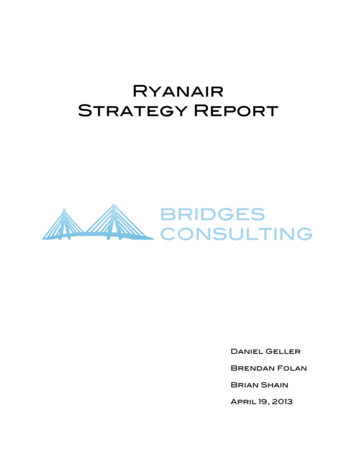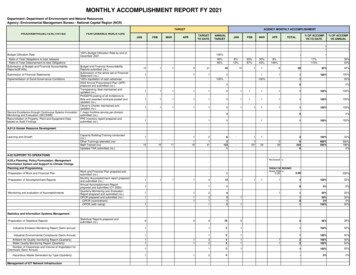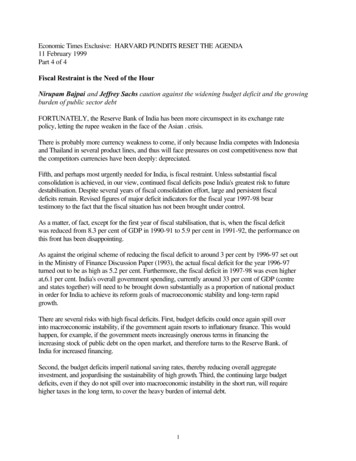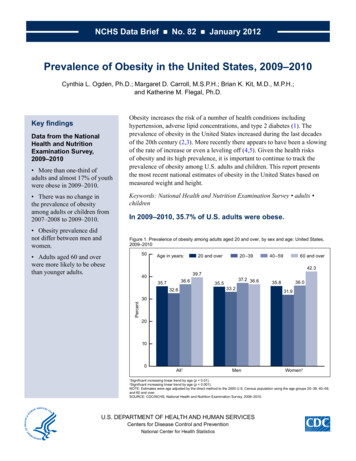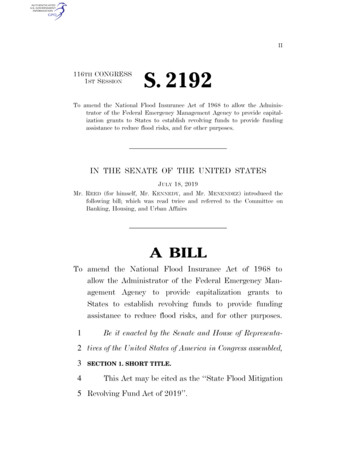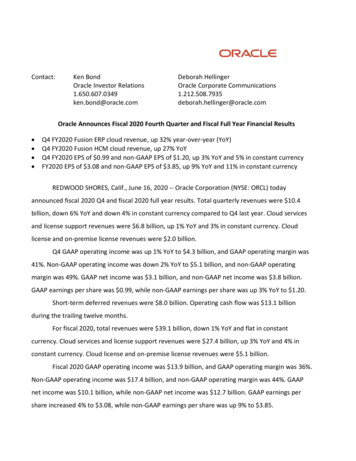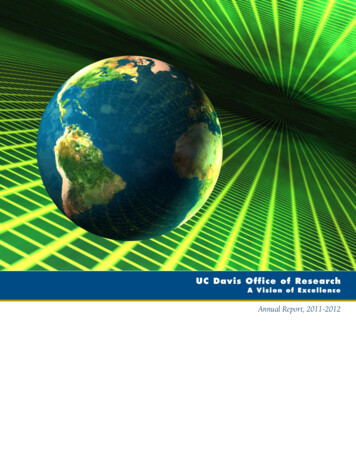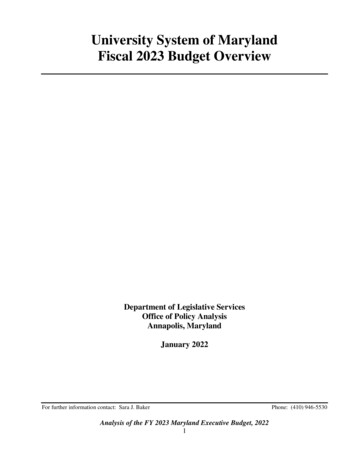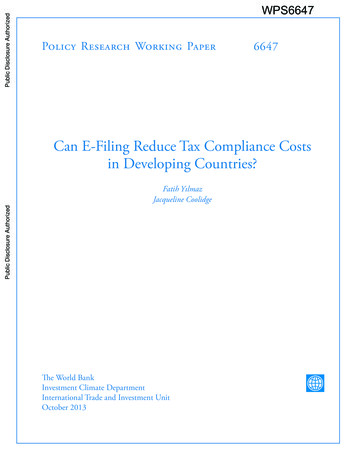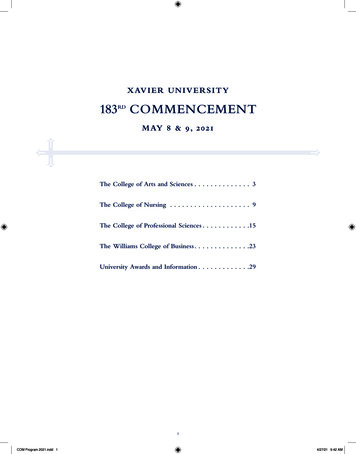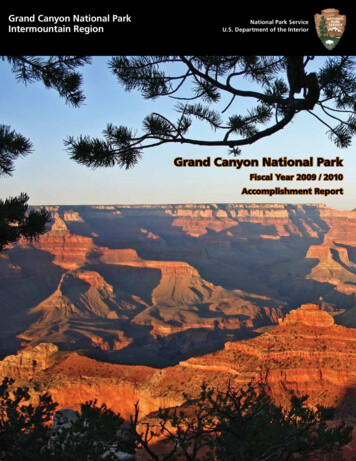
Transcription
Grand Canyon National ParkIntermountainRegionnd CanyonNational Park2009 Accomplishment ReNational Park ServiceU.S. Department of theInteriorAccomplishment Rep2009/2010Grand Canyon National ParkFiscal Year 2009 / 2010Accomplishment Report
Grand Canyon is a geological wonder. It is a place of great biological diversityand serves as an ecological refuge. Grand Canyon has internationallyrecognized scenic vistas, qualities, and values. With an ever-changing landscapeand colorful scenery of vast proportions, it is widely considered one of theworld’s most beautiful natural areas. The inspirational and spiritual values ofthe canyon project a sense of timelessness. Present and future generations need toknow that the National Park Service will continue to protect the canyon, as wellas the heritage, the places and the events of America’s past, present and future.
Grand Canyon National Park2009 / 2010 key accomplishmentsCONTENTSMessage From the Superintendent.1Park Highlights.2Verkamp’s Visitor Center.2Trail of Time exhibit plan.3Protecting and improving the canyon for future generations.4Presidential and Vice Presidential visits to Grand Canyon National Park.5Rehabilitation of Inner Canyon corridor trails.6Hermits Road Trail. .6Pavement preservation project for all park roads.7Rehabilitation of remote and historic Inner Canyon ranger stations. .7Employee housing.8Supai Camp housing.9Visitor Center and Mather Point improvements. 10South Rim entrance station. . 11New Science and Resource Management building. 11Shrine of the Ages and and headquarters upgrades. . 12Watchtower rehabilitation. 13New park office space in Flagstaff. . 13Division of Interpretation and Resource Education. 14Greening the Canyon: Photovoltaic panels at Grand Canyon Visitor Center. 14Artist-in-Residence program. 15Design for new visitor center exhibits. 16Summer youth camp program. 17International programs. 18Division of Science and Resource Education. 19Resource stewardship. 19Outreach activities. 20Volunteerism. 21Science and monitoring programs. 22Division of Visitor and Resource Protection. 23Preventative search and rescue. . 23Search and rescue. 23Emergency medical services. 23Fire and aviation. 24Fee collection. 24.
2009 / 2010 key accomplishments (continued)Division of Facility Management. . 25Remodeling of Verkamp’s Curio Shop. 25Pasture Wash Road rehabilitation. 25Water and wastewater systems. 26American Recovery and Reinvestment Act funding. 26Automation of Indian Garden Pumping Station. 27Energy audit for all Grand Canyon facilities. 27Greenway V Trail. . 27Project Management Team. . 28Narrow Band radio conversion. 28New dispatch center. . 28Parkwide restroom iimprovements, Phase 2. 29Desert View Visitor Contact Station. . 29Water bottle filling stations. 30Boat house improvements. 30Division of Conessions Management. 31Division of Administrtion. . 32Division of Partnerships and Employee Programs. 33Generating Organizational Advancement and Leadership (GOAL) program . 33Diversity. . 34Park-wide volunteer program. 34Partnerships. 35Fundraising goals with the Grand Canyon Association. 35Grand Canyon river heritage museum. . 36Grand Canyon art museum. 36
Grand Canyon National Park2009/2010 Accomplishment ReportThe Trail of Time is an interpretive walkingtimeline trail that focuses on Grand Canyonvistas and rocks to guide visitors to ponder,explore, and understand the magnitude ofgeologic time and the stories encoded byGrand Canyon rock layers and landscapes.NPS photo
Grand Canyon National Park2009/2010 Accomplishment ReportMessage from the SuperintendentThis report provides a summary of key accomplishments by thestaff of Grand Canyon National Park in the last two years. Thegenesis of these accomplishments starts in 2007 with a series ofgoals set for the park by the Washington and Intermountain Regionoffices, and the Grand Canyon management team. Over the last 35years, I have been involved in the management of parks from manydifferent perspectives. The accomplishments by the staff at GrandCanyon, however, surpass anything I have seen from the manyincredible management teams I have worked with.Steve P. MartinSuperintendent At the start of 2007, Grand Canyon had several major managementchallenges, including:A dysfunctional transportation system with two-hour waits at the entrance station andchaotic parking along the South RimA visitor center that was virtually inaccessible to visitorsA partnership with key fund-raising partner that had disintegrated and no longerfunctionedAn administration division in shambles over contracting and accounting misstepsthat led to the Pacific General, Inc. (PGI) contracting predicament and a backlog ofunfinished projectsEmployee morale and housing issuesConcession concerns, including the accounting and tracking of millions of dollars inleasehold surrender interestsProblems with basic infrastructure, including office space, housing for the HavasupaiTribe, and roads and trailsKey planning projects that needed to move ahead, including the restoration of naturalquiet to the park, the park’s fire management plan, and key visitor use needsThe lack of a central visitor center at Desert View and on the South Rim and lack of keyinterpretive opportunities such as a park filmContinued impairment of canyon resources by Glen Canyon Dam operations that didnot recognize the National Park Service role in managing the parkA lack of any “greening” projects for key infrastructure, which could serve as examplesfor sustainabilityThese are just a few of the major challenges the staff took on. They also continued to providefor the safety, care and rescue of visitors, implemented innovative programs in all of theirfields and worked to be proud stewards for the NPS. This summary highlights the work ofthe Grand Canyon staff and is a tribute to their professionalism.1x
Grand Canyon National Park2009/2010 Accomplishment ReportPark HighlightsVerkamp’s Visitor CenterIn November 2009, the park opened the Verkamp’sVisitor Center in Grand Canyon Village. This facilityhad served as a family-run concessions operationfor over 100 years. Through innovative managementstrategies, it was purchased by the National ParkService (NPS) to be converted to the first visitor centeron the South Rim. Prior to the opening of this facility,the park had no permanent presence in the Villageareaand was not able to serve the large number of visitorswho, arriving in the park by train, had limitedopportunities to interact with park staff. In addition,park staff designed and oversaw the installation ofnew exhibits on the history of Grand Canyon NationalPark -- an opportunity to tell a little-known story ofthe park’s history. Through an excellent partnershipthese exhibits were funded by the Grand CanyonAssociation.Verkamp’s Visitor Center. NPS photoThis rim-side visitor center occupies one of the oldest buildings in Grand Canyon Village.Operated as a curio shop for more than 100 years by the Verkamp family, the building nowfeatures displays on the history of the South Rim and houses a Grand Canyon Associationbookstore.2
Grand Canyon National Park2009/2010 Accomplishment ReportTrail of Time exhibit planHow do you bring geology and geologic time tolife? The park partnered with the University ofNew Mexico to design the Trail of Time (TOT), aninterpretive walking trail along the South Rim. Itfocuses on Grand Canyon vistas and rocks to guidevisitors to ponder, explore, and understand themagnitude of geologic time and the stories encodedin Grand Canyon rock layers and landscapes. Exhibitplans for the TOT were finalized in the late summer of2009 and the trail opened in the fall of 2010. Fundedby a National Science Foundation grant, the TOTincludes introductory portals, wayside exhibits,rock samples, and viewing tubes. These allow parkvisitors to see and touch rocks from each geologiclayer within the canyon – rocks otherwise onlyaccessible to those able to hike into the depths of thecanyon or to raft the Colorado River.The Trail of Time is an interpretivewalking trail that focuses onGrand Canyon's vistas and rocks,encouraging visitors to ponder,explore, and understand themagnitude of geologic time andthe stories told by the canyon'srock layers and landscapes.Walking the trail gives parkvisitors a visceral appreciation forthe magnitude of geologic time.NPS photos3
Grand Canyon National Park2009/2010 Accomplishment ReportProtecting and improving the Canyon for future generationsPark staff worked with other Department of Interior(DOI) agencies on the need to limit mining withinthe Grand Canyon watershed. After Secretary ofthe Interior Ken Salazar announced an exclusionof public lands around the park from mineralsdevelopment, staff cooperated with the Bureau ofLand Management (BLM), U.S. Geological Survey(USGS), U.S. Fish and Wildlife Service (USFWS) andthe U.S. Forest Service (USFS) on technical baselinestudies of resource conditions in the greater GrandCanyon region. As part of the DOI uranium miningeffects effort, park staff undertook studies of seeps andsprings, aquatic invertebrates, amphibians, vegetation,wildlife, natural sounds, and ethnographic resources.Water releases from Glen Canyon Dam continueto affect park resources and preservation efforts.The park has played a leadership role in workingwith other DOI bureaus to develop “desired futureconditions” for park resources affected by damoperations.They also continued to collaborate with theDOI “family” in the Glen Canyon Dam AdaptiveManagement Program, working to restore high flowprotocols and on other key science and managementprograms. The staff at Grand Canyon wasinstrumental in advocating for the successful 2008high-flow event. As a result, the park provided DOIwith solutions to problems created by dam operations.These solutions do not affect water allocations toColorado River states. They will have only minoreffects on power generation and will not increase costssignificantly for rate payers. These changes, based onscience, will help resortation efforts in Grand Canyon.Water release from Glen Canyon Dam during a high-flow experiment. NPS photo4
Grand Canyon National Park2009/2010 Accomplishment ReportPresidential and Vice Presidential visits to Grand Canyon National ParkThe Division of Visitor and ResourceProtection led and supported thepresidential family visit in August 2009 andthe vice presidential visit in July 2010.For these important occasions, the divisionprepared a comprehensive protectionprogram for visitors and park resourcesthat focused on service and continuousimprovement. This included radiodispatch and 911 emergency services, lawenforcement, wildland and structural fireprotection, search and rescue, and emergencymedical services throughout the park.These services support park management allyear long by protecting resources, 4.5 millionannual park visitors, and a permanent parkpopulation of more than 3,000 residents.Visitor and Resource Protection staff. NPS photoRight: Presidential family visit, August 2009.Below: Vice Presidential visit, July 2010. NPS photosThe Presidential Grand Canyonvacation was much like those ofother families: They came, theysaw, they left. But along the way,they thrilled visitors from all overthe globe who lined the streets ofTusayan and Grand Canyon Villageto get a glimpse of the park’s mostdistinguished visitors.5
Grand Canyon National Park2009/2010 Accomplishment ReportRehabilitation of Inner Canyon Corridor trailsRehabilitation work continues on themain corridor trails in Grand Canyon. Theimprovements have made the trails moresustainable and usable for both human foottraffic and park livestock for years to come.The repairs give the trails the necessarystructure – good walking surfaces and stableretaining walls – to endure both the harshenvironment and varied trail uses.Hermits Road TrailThe new portion of the accessible HermitsRoad Trail, which is used as a combinationhike/bike trail, has new benches in variouslocations and new signs for waysideinformation and visitor directions. Alsoalong the Hermit Road Trails, rehabilitationThe rehabilitation of the South Kaibab Trail significantly improvedof Maricopa Point viewing area and trailconditions for both hikers and stock users. NPS photonow provides handicapped accessibility. Work includedgradient corrections and paving of the trail and itsassociated viewing area. Safety rails were modified andrebuilt to allow viewing of the canyon from a wheelchair height. Stonecurbing also was installed along the trail near the canyon rim to increasesafety. The result: A safe access point for all visitors to the area.The new portion of theaccessible Hermits RoadTrail, which is used as acombination hike/bike trail.NPS photo6
Grand Canyon National Park2009/2010 Accomplishment ReportPavement preservation project for all park roadsPavement preservation, or “chip seal” work, took placeon all roads on both rims in spring and summer of 2010.The work will help preserve roads built in recent yearsand extend the life of older roads.This pavement preservation project involved crack sealing, chipsealing, and restriping most of the paved roads on the North andSouth Rims of Grand Canyon National Park. This seal coat will provideseven or more years of service without the need to rebuild the subbase and resurface the asphalt.Rehabilitation of remote and historic Inner Canyon ranger stationsThe Tuweep Ranger Station and residence is in a remote areaon the northwestern side of Grand Canyon. Far from publicutilities, it had been ignored in recent years. It was remodeledto meet building andsafety codes and improveliving conditions for staffstationed there. Utilityupgrades improved thestation’s water catchmentand treatment system andits off-grid electrical powersystem, which uses solarand wind generators.Improvements to the utility systems atTuweep residence. NPS photoWater catchment system at Tuweep that provides potablewater for residence. NPS photoIn the Inner Canyon, boththe River Ranger Station and the Phantom Ranch Ranger Station wererehabilitated. Work included new electrical, plumbing and HVAC systems.New bathrooms and energy-efficient windows were installed. Cabinetsand “ENERGY-STAR” appliances were added to the kitchens. At PhantomRanch, improvements included spaces for the clinic area and the visitorcontact station to separate them from the living quarters.7
Grand Canyon National Park2009/2010 Accomplishment ReportEmployee housingThe park completed the design and startedconstruction of 64 new units of employee housing(eight, 8-plex apartments). The park-led designwas sustainable and is expected to achieve Goldor Platinum LEED (Leadership in Energy andEnvironmental Design) ratings. (The modificationswere approved by the Development Advisory Board.)The apartments should be ready for staff in latesummer 2011.On the North Rim, five historic, external-frame cabinshave been renovated and upgraded, for a total of 15cabins available for seasonal employee housing. Thesereplace dilapidated trailers, which will be removedfrom the North Rim.We are very excited to be able to providethese new units for our employees. It is ahuge step in reducing our housing deficitand improving living conditions in the park.The current deficit affects the park’s abilityto meet critical mission needs, is often adetriment to staff morale, and severelyimpacts our ability to recruit and retainemployees.Steve Martin, superintendentThis renovation project includes replacing windows, exterior doors,and roofs; upgrading electrical systems and plumbing; refinishing orreplacing floors; repairing foundations; rodent-proofing; and installingfire sprinkler systems.8
Grand Canyon National Park2009/2010 Accomplishment ReportSupai Camp housingOne of the highlights of the park’s partnershipinitiative was the work done with the HavasupaiTribe to improve homes at a small housing area onthe South Rim known as Supai Camp. AmericanRecovery and Reinvestment Act (ARRA) funds wereobligated and a construction contract was awardedfor the construction of six new handicap-accessiblehousing units (three duplexes). This housing areawas established by the NPS in the 1930s for tribemembers who were relocated from other areas inthe park. Upgrades to water and sewage utilitieswere completed and on Aug. 5, 2010, the newduplexes were presented to the tribe. Rehabilitationis now underway on the old cabins in Supai Camp.This project fulfills past promises to the tribe andaddresses NPS concerns about living conditions andinfrastructure at the camp.The park finished upgrading water and sewagesystems at Supai Camp housing area. These dwellingshave been provided to the Havasupai Tribe since the1930s by a long-standing agreement.Through our partnership with theHavasupai Tribe, we were ableto provide adequate housingfor tribal elders and familieswho live and work on the SouthRim. Funds allocated to the parkthrough the American Recoveryand Reinvestment Act gave us theopportunity to complete this longstanding and necessary project.Steve Martin, superintendentSupai Camp ribbon-cuttingceremony, Aug. 5, 2010x
Grand Canyon National Park2009/2010 Accomplishment ReportVisitor Center and Mather Point improvementsThe park completed Phase 1 of the visitorcenter improvement project. The workincluded re-routing the road away fromthe Mather Point overlook, adding 600spaces of private vehicle parking and 40commercial bus spaces. This removesvehicles from unsafe parking along theroad shoulders and allows for resourcerestoration in the area. It provides vastlyimproved access to the visitor center andimproves access and use of park buses.Design for a new 250-seat park theaterwas completed in FY 2009 and sent tothe Development Advisory Board forapproval. Construction began on thetheater during the summer of 2010.The new amphitheater allows park visitors to view the canyon’s famous vistas from abeautiful location, while seated on native limestone. The amphitheater’s location next tothe rim seats approximately 50 – 80 people providing space for ranger talks or viewingthe canyon’s sunrises and sunsets in a peaceful setting.Work began on a new accessibility rampat Mather Point in the summer of 2010.Also, a new amphitheatre on the rim wascompleted in time for use by the Interpretive Divisionover Labor Day weekend.The Landmark Feature (a gathering spot) wascompleted in consultation with 11 affiliated tribes anddedicated on Oct. 25, 2010 (photo below).
Grand Canyon National Park2009/2010 Accomplishment ReportSouth Rim entranceThe park solved one of the greatest problemsfor park visitors when it changed theconfiguration of the south entrance station.This has reduced the average wait for a visitorfrom 1.5 hours in the summer to less than 15minutes.Grand Canyon’s South Rim entrance station.NPS photoNew Science and Resource Management buildingThe Science and Resource Management staffnow occupies offices in facilities abandoned bypark maintenance years ago. These offices arecompletely inadequate, with leaking roofs, little orno insulation, and workspaces and heating systemsdesigned for maintenance shops and vehicle bays.A new, LEED-rated facility will provide modernoffices and laboratory space. There also will be roomfor volunteer work-crew training and interactionwith park donors and partners. Construction isscheduled to begin in 2011.For six years, Science and ResourceManagement staff have had to work in threesubstandard buildings, including a formerwarehouse and a former maintenanceshop. One needs extensive roof repair orreplacement and a new heating system andboiler. Neither building is suitable for thestaff’s office and operations needs.Current working conditions for Science and ResourceManagement Staff. NPS photo11
Grand Canyon National Park2009/2010 Accomplishment ReportShrine of the Ages and park headquarters upgradesThese buildings, seen daily by numerous visitors, neededrehabilitation and improvements badly. Window-mountedair conditioners in the Mission 66-era office buildingwill be replaced with central air conditioning. Energyefficient windows and doors will replace the buildings’existing windows and doors. This work will save energy,lower costs and vastly improve the buildings’ appearance.The interior of the Shrine of the Ages,a visitor interpretation center on theSouth Rim, is in need of rehabilitation.This project will create a clean andcomfortable environment for all visitorsand park residents. It also will complywith handicap-accessibility laws andwill improve safety where visitorsapproach the shrine. NPS photosThe idea for an interfaith chapel at Grand Canyon dates back to1917. It was not until 1952 that the Shrine of the Ages Chapel Corp.was formed, design plans were drafted, and fundraising was begun.The corporation included representatives of Catholic, Jewish andProtestant denominations. Its goal was to build a permanent structureon the South Rim of the canyon, near a site already used for religiousrites, including a very popular Easter sunrise service.12
Grand Canyon National Park2009/2010 Accomplishment ReportWatchtower rehabilitationThe division completed designengineering and compliance andbegan rehabilitation constructionon the Desert View Watchtower.This work will restore many of thetower’s external elements and resolvelong-standing deterioration thatthreatened the building’s future. Workis almost completed so that the parkcan continue to use and protect thisNational Historic Landmark building.Repair and restoration have rescued thefour-story Desert View Watchtower fromdeterioration. This historic structure, builtin 1932, evokes the ancestral Puebloanculture and architecture of the GrandCanyon region. NPS photoNew park office space in FlagstaffIn December 2009, Grand Canyon administrativestaff moved into newly acquired space in Flagstaff,consolidating several offices and providing workareas for about 65 employees, including GrandCanyon Association staff. These employees sharespace with the U.S. Forest Service under the ServiceFirst doctrine to serve the public and cooperatorsbetter. The move to Flagstaff has helped the parkdeal with its housing shortage. Themove also adheres to the park’s GeneralManagement Plan, which seeks toremove such facilities and infrastructurefrom within the park.In 2009, Grand Canyon administration moved intonew office space in Flagstaff, consolidating severaloffices and providing work areas for about 65employees, including Grand Canyon Associationstaff. NPS photo13
Grand Canyon National Park2009/2010 Accomplishment ReportDivision of Interpretation and Resource EducationGreening the Canyon: Photovoltaic panels atGrand Canyon Visitor CenterIn partnership with Arizona Public Service (APS), thelocal power company, a cutting edge interpretive andgreen energy project was completed. Seven photovoltaicpanels were donated to the park for installation atGrand Canyon Visitor Center. These panels, which wereactivated in May 2009, produce up to 18 kilowatts ofpower. This will offset the electrical needs of the visitorcenter by approximately 30 percent.Wayside exhibits outside the building and an interactiveexhibit inside explain how the system works. Thisgives visitors an understanding of the park’s and APS’scommitment to renewable energy. Project funding wasprovided by APS.The Grand Canyon Visitor Center(South Rim), with the photovoltaicsolar panels in place. Thephotovoltaic system is producingabout 30 percent of the powerused by the visitor center.NPS photos14
Grand Canyon National Park2009/2010 Accomplishment ReportArtist-in-Residence programThe history of the national parks and Grand Canyonis tied directly to connecting people to conservationthrough art. Using space in the recently acquiredVerkamp’s building, the park has begun a yearround Artist-in-Residence program for the SouthRim. Given the ability to provide newly focused timeand professionalism on the program, the park hasrewritten the criteria for both the North Rim andSouth Rim programs to meet higher artistic andprofessional standards. These new standards focuson representing and interpreting the conservation,preservation, and inspirational missions of NPS in theselection of artists-in-residence and their work.“Imminent Depth” (2007, acrylic and oil penon canvas), by Susan Klein, Artist-in-Residence,summer 2007 (North Rim) and September2009 (South Rim). NPS photo"Down a Few Thousand" (acrylic painting on canvas), by British Columbia artistDavid Alexander; Artist-in-Residence, June 2010 (South Rim). NPS photoFew places have inspired as much wonder and creativity as Grand Canyon. Thepark hosts two Artist-in-Residence programs: A seasonal program on the NorthRim and a year-round program on the South Rim. Artists of all genres, selectedby a formal jury, are awarded three-week residencies. During their time at thecanyon,
Grand Canyon National Park 2009/2010 Accomplishment Report 2009 Accomplishment Report National Park Service U.S. Department of the Interior Grand Canyon National Park Intermountain Region Grand Canyon National Park Fiscal Year 2009 / 2010 Accomplishment Report. Grand Canyon is a geological wonder. It is a place of great biological diversity and serves as an ecological refuge. Grand Canyon has .
